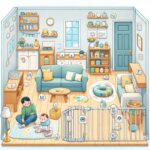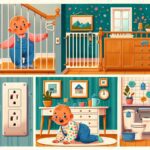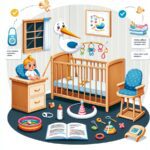Wondering how to baby-proof your home effectively? As your little one starts to crawl, walk, and explore, every corner of your home turns into an adventure zone. While this is a significant developmental milestone, it also introduces a myriad of safety concerns. Baby-proofing your home isn’t just about safeguarding your baby; it’s about giving them the freedom to explore safely. In this comprehensive guide, we will walk you through the essential steps to create a baby-friendly home, ensuring your peace of mind.
Understanding the Basics of Baby-Proofing
Baby-proofing is the process of making a home safe for infants and young children. This involves identifying potential hazards and implementing measures to prevent accidents. The goal is to create an environment where your baby can explore without coming to harm. From securing furniture to covering outlets, baby-proofing encompasses a wide range of actions tailored to different stages of your child’s growth.
It’s crucial to start baby-proofing before your child starts crawling, as this gives you ample time to identify and address hazards. A thorough home assessment is the first step in how to baby-proof your home effectively. Look for sharp edges, accessible electrical outlets, small objects that could be choking hazards, and any other potential dangers. Remember, baby-proofing is an ongoing process that evolves with your child’s abilities and needs.
How to Baby-Proof Your Home Effectively?
To ensure your home is a safe haven for your little explorer, follow these essential baby-proofing steps. First, secure heavy furniture and TVs to the wall to prevent tipping. Use furniture straps and wall mounts to anchor these items securely. Next, install safety gates at the top and bottom of stairs to prevent falls, a common cause of injury in young children. Also, ensure that all electrical outlets are covered with safety plugs or plates, especially those within your baby’s reach.
Another vital aspect of baby-proofing involves securing cabinets and drawers. Use locks or latches to keep harmful substances, sharp objects, and breakables out of reach. Additionally, installing corner and edge guards on furniture can prevent injuries from sharp edges. Don’t forget to secure cords from blinds and curtains out of reach to avoid strangulation hazards. By taking these steps, you can significantly reduce the risks within your home, making it a safer place for your baby to grow and explore.
Room-by-Room Baby-Proofing Checklist
Baby-proofing is more effective when tackled room by room. Each area of your home presents unique hazards. In the kitchen, secure appliances, use stove guards, and keep knives and cleaning agents out of reach. In bathrooms, use toilet locks to prevent drowning risks and set your water heater below 120°F to avoid scalds. Living areas require securing bookshelves, using cordless window treatments, and keeping small objects out of reach. Bedrooms should have secure furniture and safe sleeping spaces that meet current safety standards.
Don’t overlook outdoor spaces. Ensure pools are fenced with self-latching gates and balconies are secured with childproof locks. Regularly inspect your home for new hazards as your child grows and explores more. Refer to online resources like the Consumer Product Safety Commission for up-to-date safety device recommendations. Integrating these steps into your baby-proofing process will help create a safer environment for your child.
Advanced Baby-Proofing Tips
Beyond the basics, consider advanced baby-proofing measures for added safety. Utilize door knob covers and full-length door gates to restrict access to off-limits areas. Invest in window guards and anti-tip devices for ovens and refrigerators. For tech-savvy parents, smart home devices can monitor your child’s movements and secure dangerous areas electronically.
Remember, supervision is the best safety measure. No amount of baby-proofing can replace the watchful eye of a caregiver. Regularly re-evaluate your home for potential hazards as your child grows and their curiosity expands. Implementing these advanced strategies alongside basic baby-proofing measures will enhance your home’s safety, allowing your child to explore in a secure environment.
To further assist in your baby-proofing journey, consider consulting resources such as our in-depth guide on the subject. Remember, the goal of baby-proofing is not to hinder your child’s exploration but to ensure that they can do so safely. With the right precautions in place, you can create a home where your child is free to grow, learn, and explore without undue risk.













